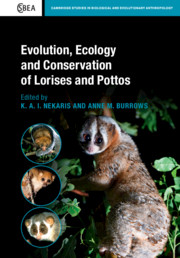Book contents
- Evolution, Ecology and Conservation of Lorises and Pottos
- Cambridge Studies in Biological and Evolutionary Anthropology
- Evolution, Ecology and Conservation of Lorises and Pottos
- Copyright page
- Dedication
- Contents
- Contributors
- Foreword
- Acknowledgements
- 1 Introduction
- Part I Evolution, Morphology and the Fossil Record
- Part II Ecology and Captive Management
- Part III Research, Trade and Conservation
- References
- Index
1 - Introduction
Overview of Lorises and Pottos
Published online by Cambridge University Press: 29 February 2020
- Evolution, Ecology and Conservation of Lorises and Pottos
- Cambridge Studies in Biological and Evolutionary Anthropology
- Evolution, Ecology and Conservation of Lorises and Pottos
- Copyright page
- Dedication
- Contents
- Contributors
- Foreword
- Acknowledgements
- 1 Introduction
- Part I Evolution, Morphology and the Fossil Record
- Part II Ecology and Captive Management
- Part III Research, Trade and Conservation
- References
- Index
Summary
This book started as a conversation in New Orleans back in 2016. A morphologist and a primatologist were sitting at the American Association of Physical Anthropologists annual meeting, bemoaning the scant presentations on lorises (slow lorises, slender lorises, angwantibos and pottos) relative to galagos, lemurs, monkeys and apes. Not only where were the talks on these primates, but where were the books on lorisids? After a few minutes of this talk, we decided it was time to see to it ourselves. Using a cocktail napkin and later a more respectable legal pad, we started sketching out what we would each want to see in a collected, edited volume devoted to what we know about lorises, some of the least understood primates living today. What resulted from that afternoon in a New Orleans bar is this edited volume. The scope is intentionally broad and is primarily divided into sections on evolution and morphology, behaviour and conservation. We also purposefully focused on soliciting short contributions, set as boxes within the text, from young authors doing fieldwork in Asian range countries, places where scientific study and conservation efforts on Loris and Nycticebus, the Asian lorises, is producing previously unknown data on population density and specific challenges to conservation efforts.
- Type
- Chapter
- Information
- Publisher: Cambridge University PressPrint publication year: 2020



